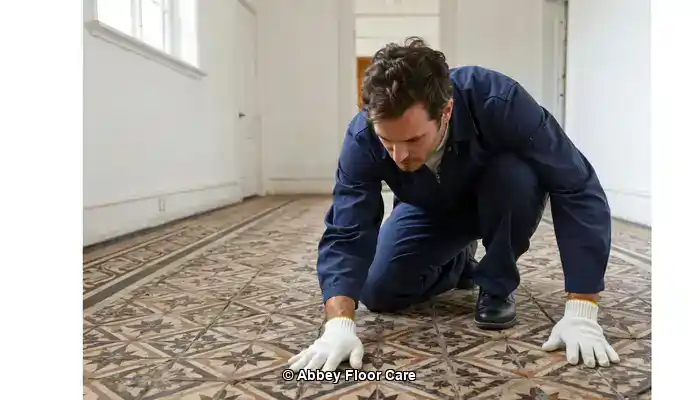
Last Updated on October 30, 2025 by David
Uncover Effective Strategies to Restore Colour and Pigment to Faded Victorian Mosaic Tiles
- Victorian mosaic tiles frequently lose their colour due to accumulated dirt, aged coatings, and surface abrasions, not merely the passage of time.
- Aggressive scrubbing and harsh chemicals can erode original pigments, particularly on encaustic and geometric tile designs.
- Safe restoration begins with thorough cleaning using pH-neutral solutions in conjunction with low-speed rotary machines equipped with soft brushes.
- To reveal the true condition of the tile surface, it is imperative to carefully remove old sealers and waxes.
- Colour enhancement is achievable through the application of breathable, stone-safe sealers that enhance the tone without creating a glossy finish.
- Professional restoration can restore original pigments without the need for repainting or artificial colouring, thus preserving the authenticity of the tiles.
- Maintaining restored tiles involves gentle cleaning routines and steering clear of acidic or bleach-based cleaning products.
- Heritage-sensitive methods protect the aesthetic and historical significance of the tiles.
Exploring the Art and Science of Restoring Victorian Tiles
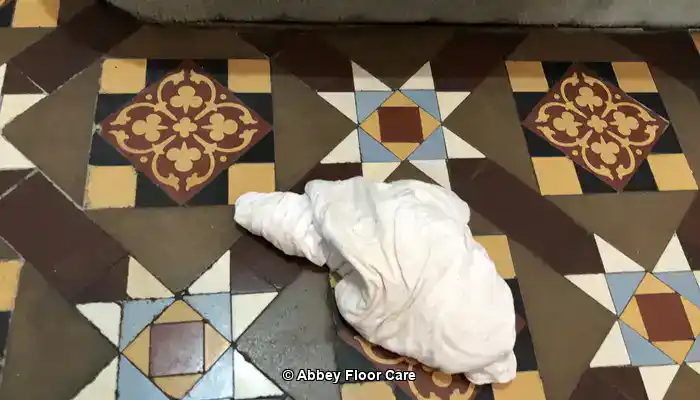
Abbey Floor Care restoring the colour to a Victorian clay tile floor using a colour-enhancing impregnating sealer.
Victorian encaustic and mosaic tiles represent more than just flooring materials; they encapsulate a significant aspect of British architectural heritage, renowned for their intricate artistry and distinctive colour palettes created from mineral pigments that are fused within the clay tile bodies. These tiles narrate a tale of the era they originate from and demand dedicated care and restoration efforts since they often lose their original vibrancy due to various factors, including exposure to environmental elements and wear from foot traffic.
Pro Tip: Choose the Ideal Products for Daily Maintenance of Victorian Tiles
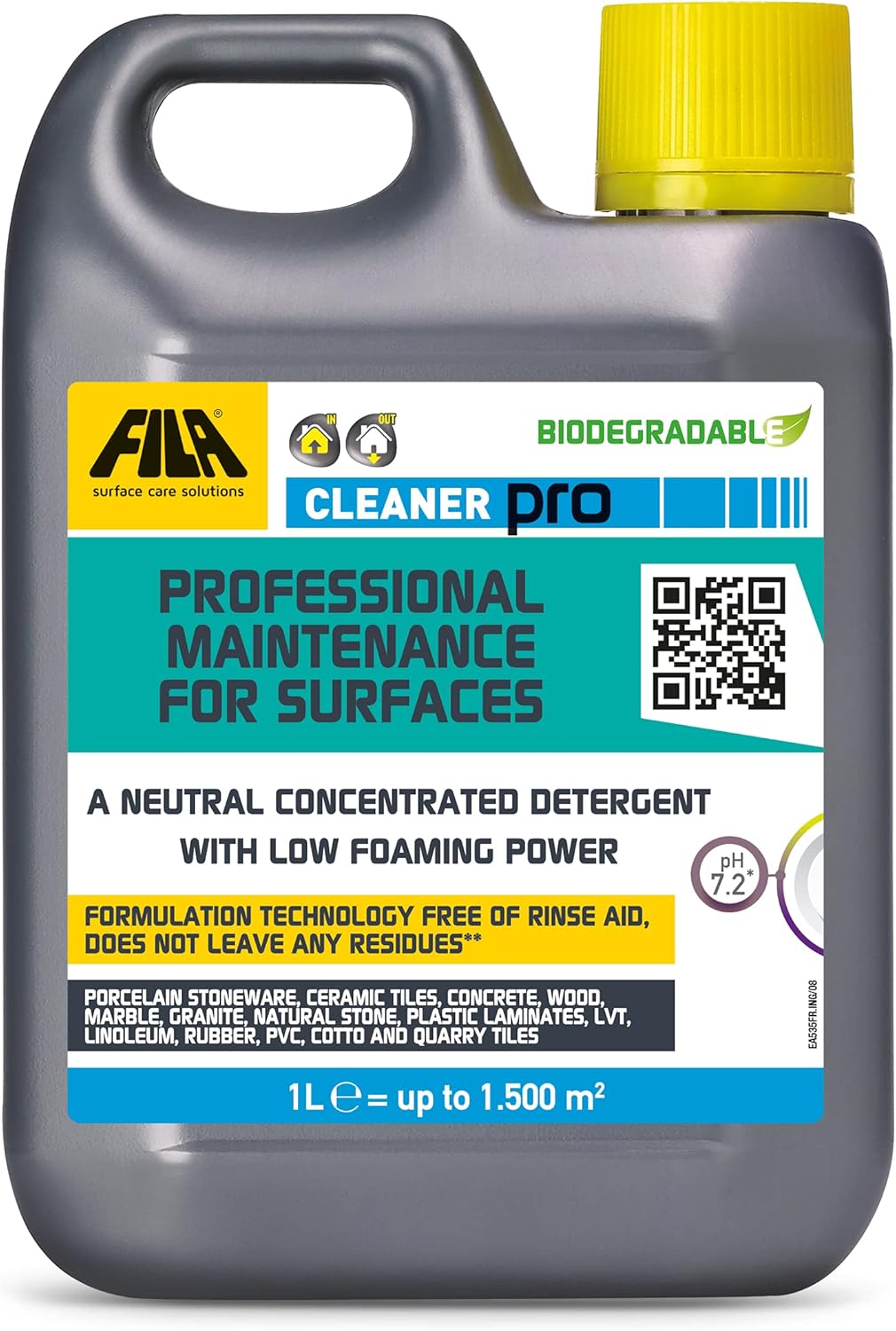
Fila Pro Floor Cleaner
|
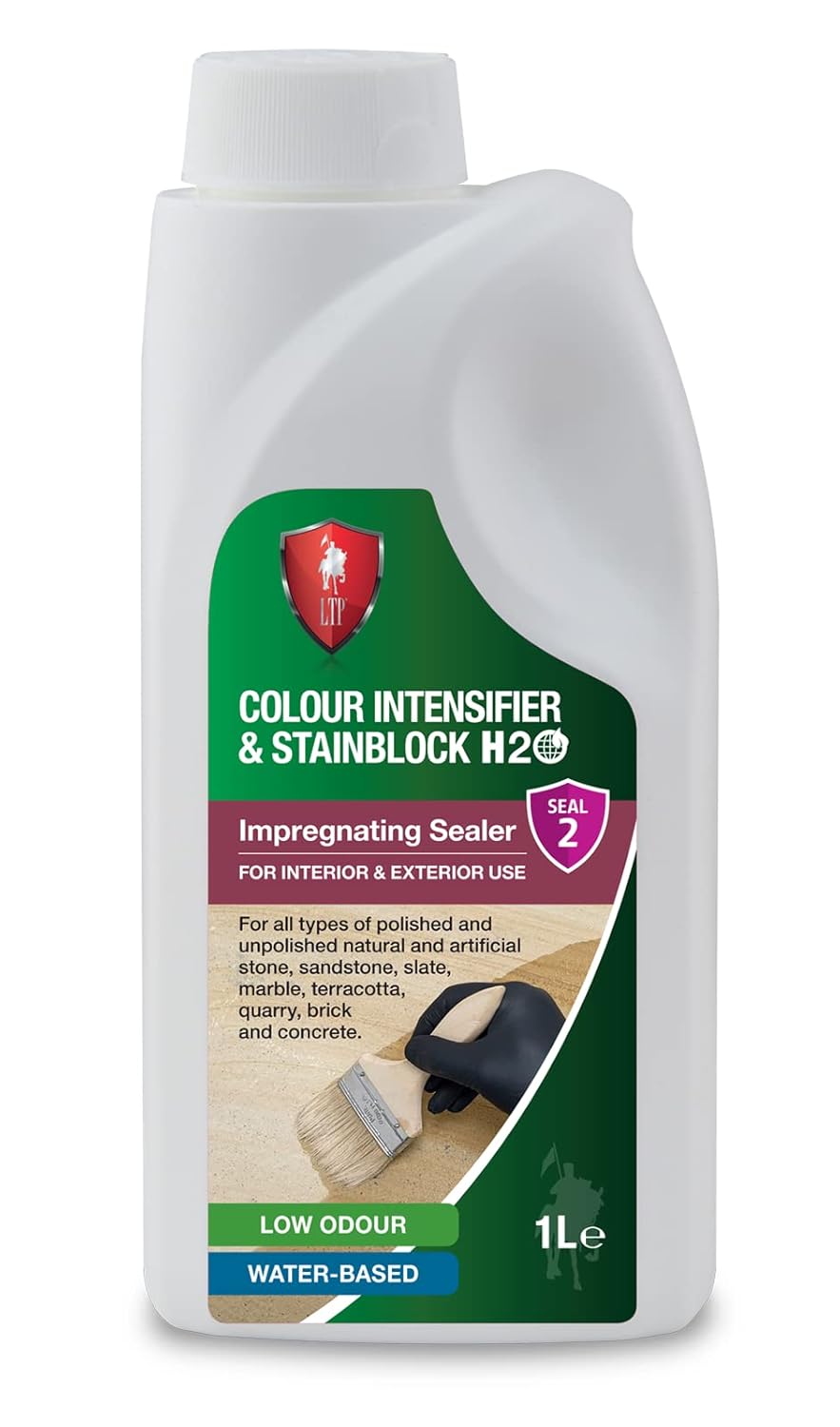
LTP Colour Intensifier & Stainblock H20
|
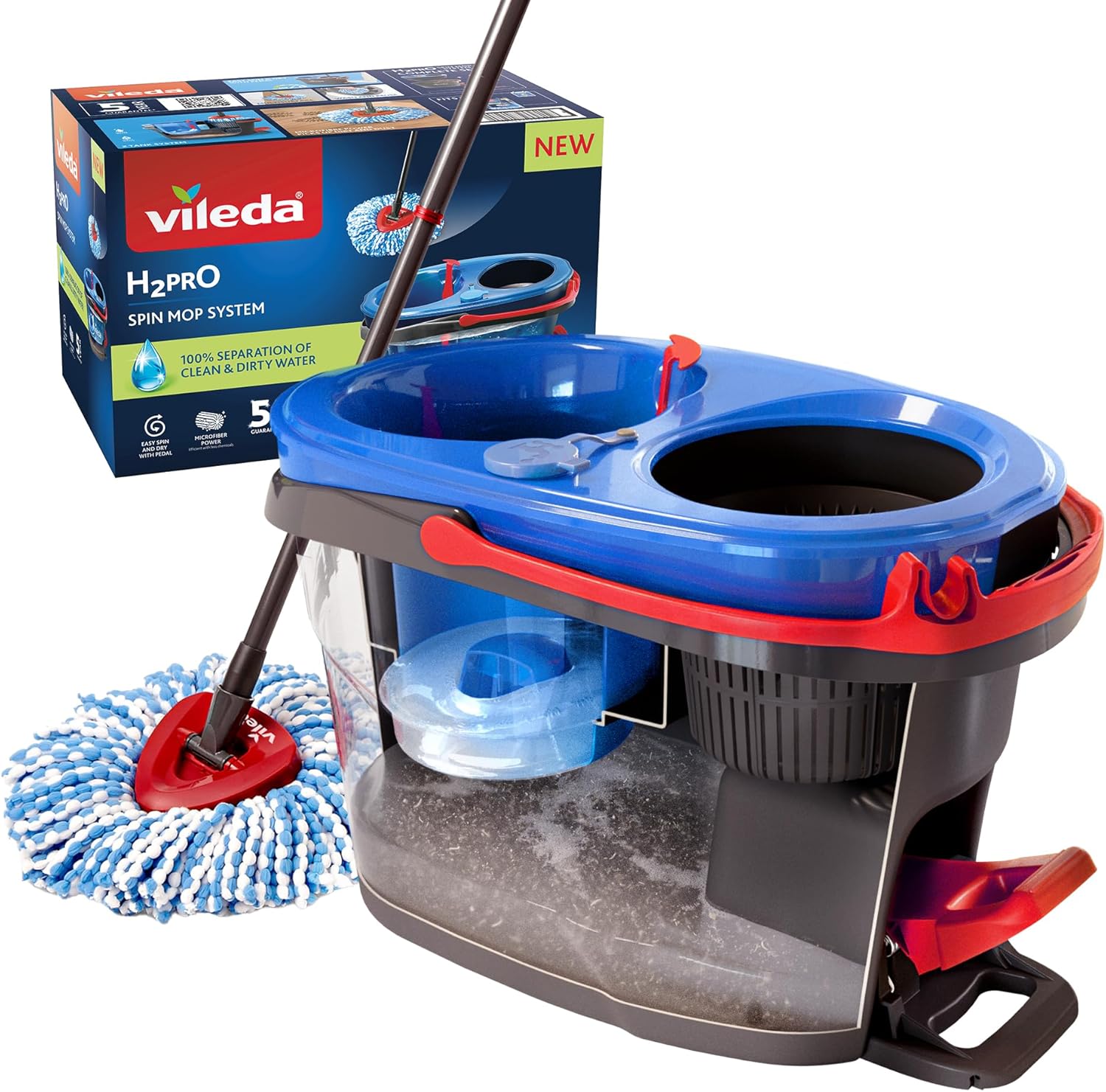
Vileda H2PrO Spin Mop System
|
Over time, these exceptional tiles often lose their visual impact due to surface wear, chemical interactions, and environmental factors that accumulate. Restoring their original vibrancy is a specialist task that demands a profound understanding of the materials, historically accurate techniques, and high-quality products tailored to the specific requirements of Victorian tiles. Using the appropriate products can significantly enhance both their longevity and aesthetic appeal.
What Causes Victorian Mosaic Tiles to Fade, and Which Factors Contribute to Surface Dulling?

Example of Victorian Clay Tile Floor dulled through surface wear and damage.
While the pigments are essential to the tile's aesthetic, numerous factors contribute to fading and dulling, including:
- Accumulated dirt and grime: Over time, foot traffic deposits fine particles and oils that permeate porous surfaces, scattering light and muting colours, ultimately diminishing their former splendour. Regular maintenance is vital to prevent this accumulation.
- Wax and polish buildup: Layers of wax or sealants lacking breathability can trap moisture, resulting in a cloudy or yellowish appearance that obscures the tiles' original beauty. This buildup can be detrimental to the integrity of the tiles.
- Moisture-related issues: Many Victorian tiles were laid on subfloors without damp-proof membranes, leading to rising damp that transports soluble salts, which crystallise on the tile surface as efflorescence, further masking the original tones and hues. Addressing sources of moisture is essential.
- Physical abrasion: Small scratches on the surface from years of wear disrupt smooth light reflection, diminishing the tiles' visual richness and appeal. Proper cleaning and maintenance can help mitigate this type of damage.
Effective restoration carefully addresses each of these factors without compromising the historic composition of the tiles, ensuring their restored beauty and vibrancy endure over time.
The Essential Importance of Breathability When Damp-Proof Membranes are Absent
As many Victorian tiled floors rest on older subfloors that lack a damp-proof membrane (DPM), their natural clay structure must remain permeable to allow moisture from the subfloor to evaporate. Non-breathable wax coatings or film-forming sealers obstruct this evaporation pathway, resulting in moisture build-up beneath the surface. This traps salts and humidity, which can lead to efflorescence, degradation of surface minerals, and the undesirable phenomenon known as wax blooming—a whitish film or haze on the tiles. Restoration plans must prioritise breathable impregnating sealers that protect the tiles while allowing moisture vapour to escape freely, preventing long-term damage and safeguarding the tiles' integrity.
Gain Insight into the Composition and Pigmentation of Victorian Tiles

An example of different pigments in a Victorian Clay tile floor during restoration by Abbey Floor Care
Mineral Oxide Pigments: The Core Components of Victorian Tiles
Victorian mosaic and encaustic tiles derive their characteristic earthy colours from mineral oxide pigments embedded directly within the clay. These pigments not only contribute to durability but also offer extensive colour depth, which is crucial for the longevity of the tiles. The primary pigments involved include:
- Iron oxide: produces terracotta reds, rust browns, and soft ochres, evoking warmth and charm.
- Manganese: yields deep browns and rich blacks, adding depth to the design and overall aesthetic.
- Cobalt: imparts a variety of blue tones that enhance sophistication and elegance.
- Chromium: creates natural green shades that invite a touch of the outdoors into interior spaces, boosting visual appeal.
The Critical Firing and Fusion Process of Tile Manufacturing
During the manufacturing process, the tiles are fired at temperatures around 1100°C, which vitrifies the clay and fuses the pigments deeply into the tile body. This vital process ensures that the colour permeates throughout the tile rather than simply resting on the surface. As a result, this offers long-lasting vibrancy and resilience against environmental elements, making them suitable for high-traffic areas.
Porous Unglazed Finish: A Dual Challenge for Victorian Tiles
Victorian tiles typically exhibit a porous, unglazed matte finish that imparts a natural appearance. However, this porosity renders the tiles absorbent and vulnerable to surface contamination and moisture, necessitating careful cleaning and maintenance to prevent permanent damage. Regular scheduled maintenance can significantly enhance their longevity and aesthetic appeal.
Variability in Colour Durability: Understanding Your Tiles for Enhanced Care
Natural earth pigments, particularly in red and yellow tiles, contain fewer mineral additives compared to darker colours like black, which are formulated with manganese. This disparity means that red and yellow tiles are less durable and more susceptible to surface dishing under heavy foot traffic. This wear manifests as shallow depressions where footfall is concentrated, resulting in uneven colour intensity and a loss of surface flatness, which can detract from the overall aesthetic appeal. Proper care and a comprehensive understanding of these differences can aid in maintaining the integrity of these tiles.
Restoration Considerations: Customising Your Approach for Optimal Outcomes
Comprehending pigment composition and tile wear patterns is critical when planning restoration efforts. Softer-toned tiles require gentler cleaning methods and specially formulated impregnating sealers that respect their physical characteristics while enhancing colour vibrancy. In contrast, darker, more resilient tiles can withstand more intensive cleaning but still require breathable, colour-enhancing protection to maintain vibrancy over time. A well-informed approach is essential to ensure successful, long-lasting results.
Implementing Expert Cleaning Techniques to Revive Victorian Mosaic Tiles
Effective cleaning is crucial for restoring Victorian encaustic and mosaic tiles to their original vibrancy. However, cleaning these tiles requires a specialised approach that extends beyond the simple use of pH-neutral detergents typically recommended. Professional restorers employ carefully formulated alkaline cleaners and mechanical techniques to break down heavy soiling and old residues without jeopardising the historic fabric of the tiles, ensuring a thorough and respectful restoration process.
Debris Removal: The Fundamental First Step in the Cleaning Process
The cleaning process initiates with the meticulous removal of all loose dirt and grit using soft brushes or vacuuming with brush attachments. This preliminary step is crucial to prevent scratching the delicate tile surfaces during subsequent cleaning phases, thereby ensuring a thorough and safe restoration process that will not compromise the integrity of the tiles.
Utilising Alkaline Cleaners for Intensive Soil Removal
In contrast to pH-neutral cleaners, which often lack the chemical strength needed to tackle ingrained fatty acids and organic soils, alkaline cleaners are essential for thoroughly breaking down household oils, grease, and sticky residues commonly found on tile surfaces and within grout lines. These alkaline formulations effectively dissolve the binding agents of dirt, sugars, and fats, allowing for their efficient removal while ensuring compatibility with the mineral composition of Victorian tiles. Such tailored cleaning solutions are vital for achieving optimal restoration results.
Professional-grade alkaline products, such as PS87 PRO or custom formulations from heritage cleaning specialists, are generally used in diluted form. This ensures deep cleaning without being overly aggressive towards the clay body, thereby preserving the original characteristics of the tiles. It is crucial to remember that, even with alkaline cleaners, caution is paramount, and spot testing is highly recommended to avoid unintended damage.
Mechanical Agitation with Appropriate Pads: Maximising Cleaning Effectiveness
Mechanical action significantly enhances cleaning efficiency. Low-speed rotary scrubbers fitted with red or occasionally green non-abrasive pads are commonly employed to agitate soils from small pits, tile surfaces, and grout lines. These pads clean effectively while protecting the edges of the tiles and delicate surface details, ensuring a comprehensive cleansing experience that respects the historic value of the tiles.
Careful Removal of Waxes and Exotic Sealants: Addressing Accumulated Residues
Years of use can lead to the build-up of old waxes and sealants, particularly from DIY attempts that utilise inappropriate products. Water-based cleaners—either alkaline or mildly acidic—are preferred for removing these residues without causing damage to the tile’s mineral structure. However, persistent ‘exotic’ or solvent-resistant coatings necessitate targeted solvent-based removers such as Lithofin Wax-Off or LTP Solvex. These solvents effectively soften and emulsify waxes and old sealants, yet must be handled with care by professionals trained in their safe application and disposal to avoid potential harm.
Rinsing and Drying: Ensuring a Clean Slate for Restoration Work
After the chemical cleaning phase, thorough rinsing is essential to eliminate all cleaning residues. Multiple rinses with clean water, complemented by wet vacuum extraction, guarantee that no detergent or solvent traces remain to interfere with subsequent restoration coatings. Proper rinsing is vital to maintain the tiles' integrity and ensure their optimal performance.
Drying time can fluctuate depending on environmental conditions, such as humidity, surface type, and moisture levels. Restoration experts consistently utilise moisture meters to confirm that the tiles are completely dry before applying any impregnating sealers or protective treatments. This meticulous approach prevents moisture entrapment, which could otherwise lead to efflorescence, staining, or damage beneath sealed layers. Ensuring complete dryness is a critical step in the restoration process.
Benefits of Comprehensive Cleaning: Unveiling the True Condition of Your Tiles
Thorough cleaning reveals the actual condition of the tiles by removing visual obstructions. It exposes areas that may require repair and provides a clean, receptive surface for colour-enhancing impregnators or other restorative products. This careful preparation is fundamental to the success and longevity of Victorian mosaic tile restoration, ensuring that the tiles can be appreciated for generations to come, preserving their historical significance.
Applying Colour Enhancement Using Premium Impregnating Sealers
Restoration professionals utilise impregnating colour-enhancing sealers manufactured by LTP and Lithofin, brands renowned for their advanced, heritage-approved formulations. Unlike superficial coatings, these sealers:
- Penetrate deeply into tile pores to physically enrich colour by altering light refraction, thus enhancing the visual depth of the tiles, making them more vibrant and attractive.
- Maintain vapour permeability, which is essential for moisture escape and is particularly critical in older floors devoid of DPM layers, ensuring the longevity of the restoration and preventing moisture-related complications.
- Provide durable protection against stains and foot traffic without altering natural texture or gloss, thereby preserving the original aesthetic of the tiles that reflects their rich heritage.
- Applied in multiple light coats, each permitted to penetrate before the next is applied, ensures complete uniformity and a flawless finish that beautifully rejuvenates the tiles.
These sealers effectively tackle fading by reinstating vibrancy while preserving the breathable nature of the historic floor, making them indispensable in the restoration process and ensuring that the tiles remain visually appealing for years to come.
Expert Techniques for Repairing Damaged Tiles and Colour Tinting
Tiles exhibiting chips, cracks, or missing pieces require careful repair using tinted epoxy or lime-based mortars, colour-matched with natural mineral oxides to ensure consistency with surrounding tiles. Restoration specialists often source matching replacement tiles from salvage archives to maintain pattern continuity. Colour tinting involves selectively applying earth-pigment-infused wax or resin mixtures to sensibly blend worn or missing pattern areas while respecting tile breathability and reversibility, ensuring that future restoration efforts can be conducted if necessary without compromising the integrity of the tiles.
Best Practices in Tinting: Achieving Seamless Colour Integration
- Utilise small, controlled applications to avoid over-colouring, ensuring a natural appearance that complements the original tile.
- Conduct patch testing on inconspicuous areas before complete application to verify colour matching and avoid unintended mismatches.
- Ensure compatibility with the impregnating sealers applied to the entire surface to maintain uniformity and prevent adverse reactions that could affect the restoration.
Prioritising Ongoing Maintenance for Restored Victorian Mosaic Floors
Preserving the restored colour and condition requires continuous care to guarantee the longevity of the restoration:
- Routine cleaning with pH-neutral, non-abrasive detergents specifically designed for historic tiles is crucial for maintaining their appearance and preventing damage.
- Preventive measures, such as placing entrance mats to minimise dirt ingress and wear, can significantly prolong the life of the tiles and uphold their beauty.
- Promptly remove liquid spills, especially acidic substances like vinegar or wine, to prevent surface etching and deterioration that can compromise the tiles' integrity.
- Regularly reapply breathable impregnating sealers every 3–5 years or as wear indicates, ensuring ongoing protection and vibrancy.
- Monitoring floors for signs of efflorescence or moisture ingress, indicative of underlying damp issues, is critical for long-term preservation and should be addressed immediately.
Avoiding Common Mistakes in Victorian Tile Restoration
- Refrain from using wax treatments that can block breathability, cause efflorescence, or lead to undesirable wax blooming that detracts from the tiles' aesthetics.
- Do not apply acrylic or polyurethane sealants that trap moisture and lead to degradation, as these can cause significant long-term damage and compromise the tiles.
- Limit the use of harsh chemical cleaners, as these can erode clay and pigments, undermining restoration efforts and harming the tiles.
- Never repaint tiles; paint films alter their visual and physical properties and are irreversible, jeopardising the tile's integrity and authenticity.
- Recognise and address issues in older subfloors before sealing to prevent moisture-related problems that could affect the tiles' longevity.
Real-World Restoration Projects: Successful Implementation of Expert Techniques
Examples illustrate the effective application of these principles:
A Victorian Hallway Restoration in Sheffield
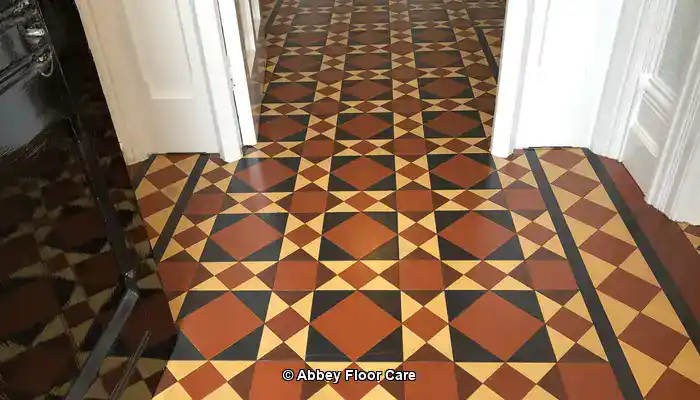
Our cleaning process successfully eliminated years of wax and grime, followed by the application of a Lantania Avo colour-enhancing impregnating sealer, which visibly deepened the colours of the tiles. This was concluded with the application of an acrylic topical sealer to provide surface protection on floors installed over a damp-proof membrane, ensuring longevity and beauty.
A Restored Civic Mosaic Floor in Chesterfield
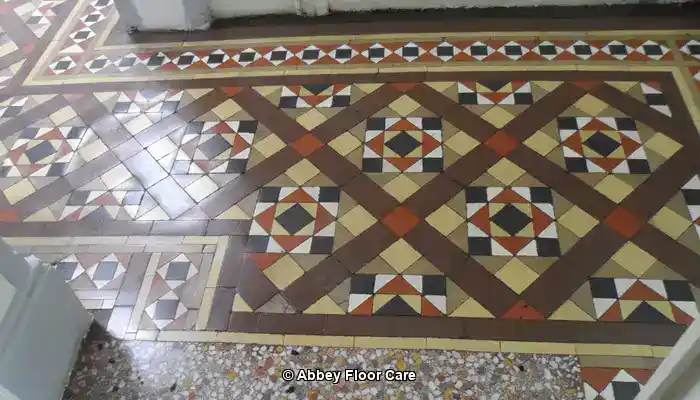
After cleaning and removing old topical sealers, the floor was sealed with an LTP Colour Enhancing Impregnating Sealer. The surface was further protected with a wax, meticulously applied to seamlessly integrate the clay tiles into the historic fabric of the building, ensuring that the tiles retained their aesthetic and historical significance for future generations to appreciate.
Preserving Heritage Through Professional Restoration: The Significance of Expert Care
Restoring the colour and pigment of Victorian mosaic tiles represents a complex task that balances material science, craftsmanship, and sensitivity to heritage values. Employing premium impregnating colour-enhancing sealers from industry leaders like Dry Treat, Lantania, and Lithofin ensures long-term breathability, protection, and colour vibrancy. Skilled cleaning, meticulous repair, and consistent maintenance are paramount in preserving authenticity while rejuvenating these historic floors for enjoyment and appreciation by future generations.
Your Questions Answered: Frequently Asked Questions Regarding Victorian Tile Restoration
What defines Victorian mosaic tiles?
Victorian mosaic tiles are decorative tiles popularised in the 19th century, distinguished by their vibrant colours and intricate patterns. They were extensively used in public buildings and private homes, embodying the architectural spirit of their era, and are now treasured for their historical significance.
How can I effectively restore faded Victorian mosaic tiles?
Restoration of faded Victorian mosaic tiles involves meticulous cleaning, repairing damages, applying new pigments to match the original colours, and subsequently sealing the tiles to safeguard them from future wear and damage, ensuring their beauty is maintained.
What materials are essential for tile restoration?
Key materials for tile restoration include specialised cleaning solutions, pigments, adhesives, grout, and protective sealants, all selected for their compatibility with the original tiles and the restoration process to guarantee optimal results.
How long does the tile restoration process typically take?
The time required for tile restoration varies based on the size and condition of the area being restored, generally ranging from a few days for smaller projects to several weeks for larger, more intricate restorations that demand extensive work and careful attention to detail.
Is it feasible for me to undertake the restoration myself?
Yes, smaller restoration projects can be accomplished as a DIY if you possess the necessary skills and tools. However, more complex repairs necessitate professional expertise to ensure quality results and adherence to historical accuracy, thereby preserving the tiles' authenticity.
What is the expected cost of restoring Victorian mosaic tiles?
Costs can vary considerably based on project size and condition, ranging from a few hundred to thousands of pounds for comprehensive restorations that involve intricate work and high-quality materials, reflecting the level of effort and expertise required.
How do I select the right restoration expert?
Seek restoration professionals with experience in historical projects, positive reviews, and a commitment to utilising authentic materials and techniques to ensure the best outcomes for your restoration, thereby protecting your investment.
What challenges do restorers typically encounter?
Restorers often face challenges such as matching original colours, repairing damaged tiles, and ensuring the longevity of the restoration work, which necessitates a careful balance of art and science to achieve satisfactory results.
What maintenance practices should I follow for restored tiles?
Regular cleaning with pH-neutral products, avoiding harsh chemicals, resealing periodically, and promptly addressing any damage are key practices for maintaining restored tiles, ensuring their continued beauty and integrity for many years to come.
What innovations have emerged in tile restoration today?
Recent innovations encompass advanced cleaning solutions, new types of sealants, and digital technology for precise colour matching and pattern replication in restoration projects, enhancing the effectiveness and accuracy of the restoration process and ensuring high-quality results.
The Article Restoring Colour and Pigment to Faded Victorian Mosaic Tiles first found on https://www.abbeyfloorcare.co.uk
The Article Restoring Colour to Faded Victorian Mosaic Tiles appeared first on https://fabritec.org
The Article Restoring Faded Victorian Mosaic Tiles to Vibrant Color Was Found On https://limitsofstrategy.com

